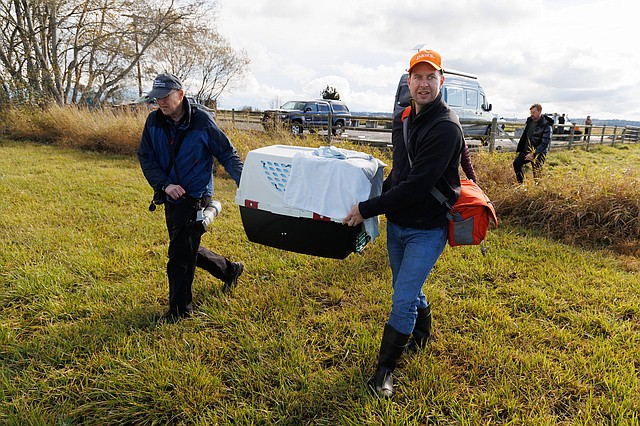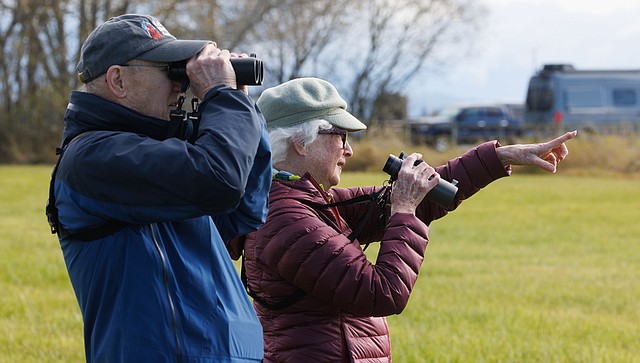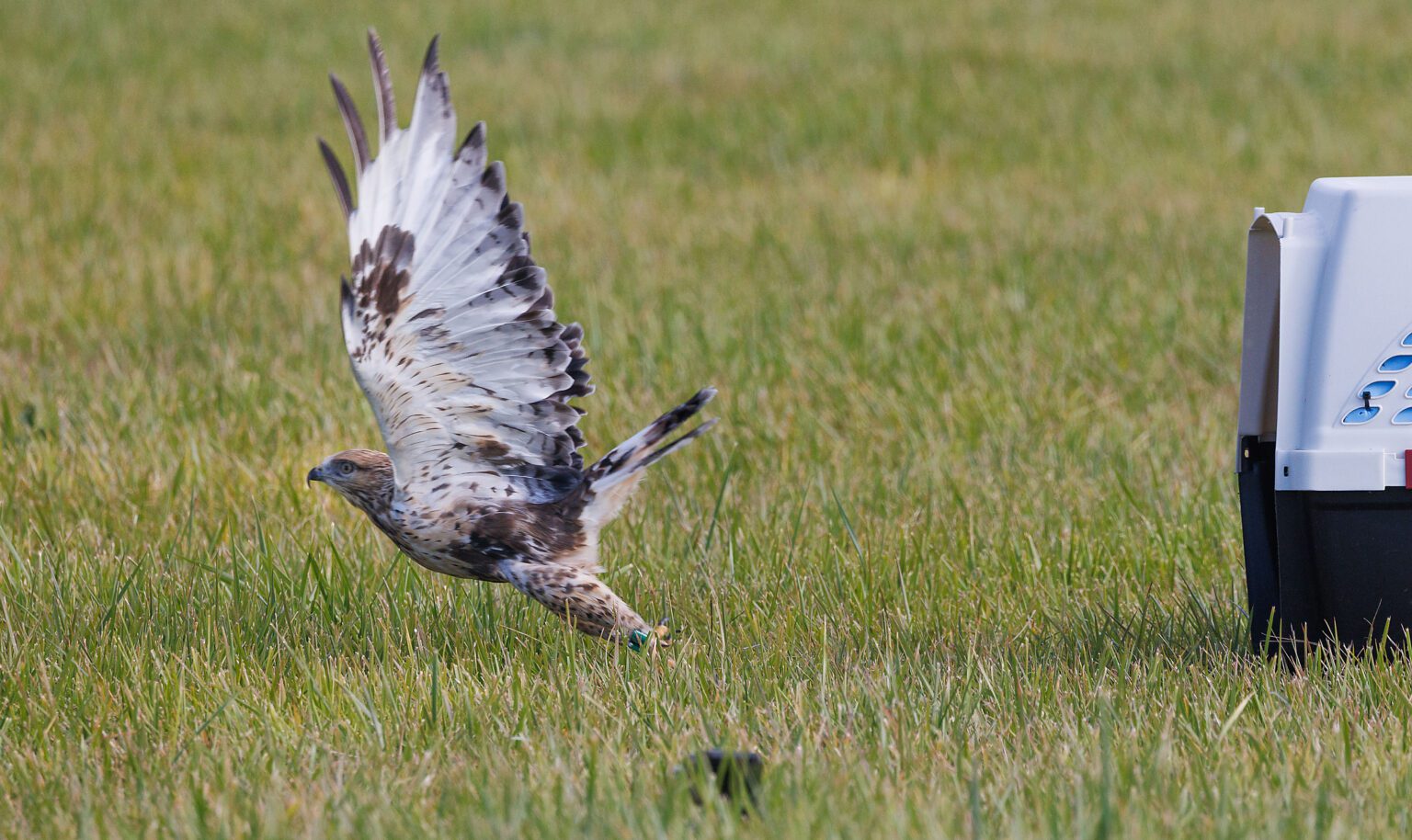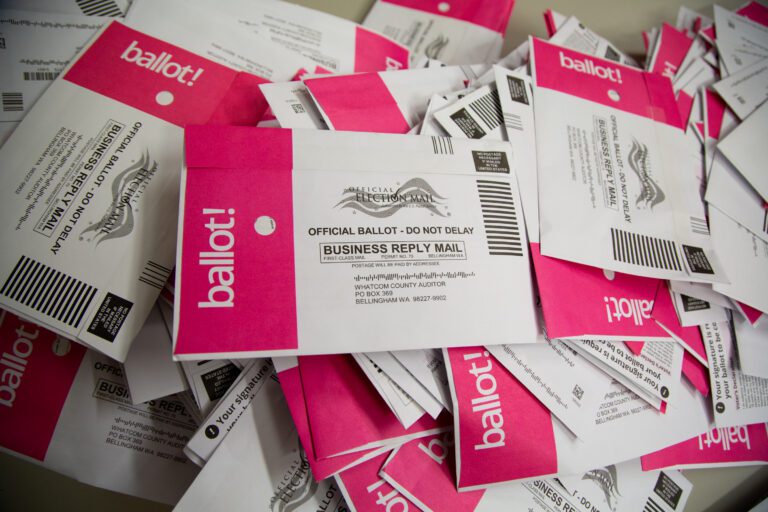A rough-legged hawk that was struck by a plane at SeaTac was released on Washington Fish and Wildlife land near Bow on Wednesday after 244 days of rehabilitation.
The Progressive Animal Welfare Society (PAWS) kept the bird at its Wildlife Center and coordinated its release, and is excited to see the hawk back out in the wild, said Jeff Brown, a wildlife naturalist for PAWS.
“Volunteers, interns, staff members, veterinarians, everyone has been super excited that the bird is leaving and made it and got to the release spot. Everyone is just overjoyed about it,” Brown said.
PAWS, which serves western Washington, receives nearly 5,000 wild animals every year in need of care, Brown said.
The Raptor Strike Avoidance Program at SeaTac, a PAWS partner that began in 2001, sent the hawk to the Wildlife Center after some of its flight feathers, or the feathers that help the hawk gain elevation and propel it through the air, were damaged in early March, Brown said.
 Carrying a crate containing a rough-legged hawk, PAWS wildlife naturalist Jeff Brown, right and volunteer Mike West walk it out into a field where it will be released bak into the wild in Bow. The bird was hit by a plane and severely injured. PAWS, a local animal rehabilitation group, nursed it back into shape for its release. (Andy Bronson/Cascadia Daily News)
Carrying a crate containing a rough-legged hawk, PAWS wildlife naturalist Jeff Brown, right and volunteer Mike West walk it out into a field where it will be released bak into the wild in Bow. The bird was hit by a plane and severely injured. PAWS, a local animal rehabilitation group, nursed it back into shape for its release. (Andy Bronson/Cascadia Daily News)
The raptor program at SeaTac is a complicated but necessary program to protect both birds and people, said Jeff Kidd, the program supervisor. The program doesn’t euthanize any potential problem birds but does try to scare off or relocate birds that are at risk. The Bellair Airporter Shuttle helps transport relocated birds north or south of SeaTac where they can be released, depending on the migration season, Kidd said.
“It’s a difficult program because you’re trying to conserve birds, do the right thing and protect people and jets,” Kidd said. “It’s a complex program, but without it, there could be really catastrophic situations.”
PAWS repaired the broken feathers using donor feathers from a rough-legged hawk that had died elsewhere. Once the wing was intact and the bird was flight tested, PAWS rehabilitation team realized two neighboring feathers were also damaged in a way that they could not be repaired, Brown said.
PAWS held the bird until it could molt new feathers to replace the ones it had lost, but in that time, the bird’s migration season passed. So, the hawk spent extra time at PAWS to sync its release with when the species was migrating to or through the area for the winter.
 As Mike West looks through binoculars, Joyce Meyer points to where a rough-legged hawk is flying after being released into the wild on Wednesday in Bow. (Andy Bronson/Cascadia Daily News)
As Mike West looks through binoculars, Joyce Meyer points to where a rough-legged hawk is flying after being released into the wild on Wednesday in Bow. (Andy Bronson/Cascadia Daily News)
“The big issue was releasing the bird at the right time,” said Mick Szydlowski, communications director for PAWS. “It’s following its migratory path, the time of year, its food sources.”
Rough-legged hawks migrate south for the winter, but nest in the arctic, according to the Audobon Society. Releasing the bird in the summer, in hot temperatures and with territorial eagles abound in the fields the hawk would have hunted in, would have been risky, Brown said.
The bird flew out of the crate and went straight for a grove of trees nearby to perch for a moment before flying south across the marsh. The bird is banded with a green anklet with two E’s, and if birders in the Skagit Valley spot it, they can report its sighting to the Washington Department of Fish and Wildlife.
A previous version of this story incorrectly stated the number of birds PAWS rehabilitates each year and the letters on the bird’s anklet. Two paragraphs about the donor feathers and the migratory pattern were clarified. The story was updated to reflect these changes at 8:55 p.m. on Nov. 4. Cascadia Daily News regrets these errors.




